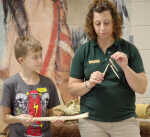History comes to life: Area fourth graders take part in 11th annual Missouri History Day

By Lynn A. Wade
Nevada Daily Mail
Area fourth graders spent a day-long tour into portions of the 19th century Thursday, as they made their way through nine stations where presenters offered insights into aspects of frontier and Civil War-era life in the Midwest.

On the grounds behind the Bushwhacker Jail, Jim Beckner of Raymore, a living history interpreter with the Missouri/Kansas Border War Network, offered a presentation called "Muskets and Mini Balls: Life of a Civil War Soldier." The accoutrements of a Civil War cavalry soldier were central to his presentation. Beckner told the listening fourth graders that Civil War cavalry soldiers was some of the best-equipped soldiers of that time.
Armed with a horse, a rope, a knife, a rifle, pistols and more, these soldiers benefitted from improvements in firearm technology along the way. A seven-shot carbine used by the Union soldiers at the Battle of Westport in October 1864 was a big factor in the Union victory there; Marmaduke's Confederate soldiers were using single shot rifles; the Iowa regiment fighting at Westport was using the carbines.
Advancements in pistols helped, too; interchangeable cylinders were developed that simplified reloading and lessened the need for carrying numerous pistols for use in battle.

The Confederates did have some technologically advanced firearms as well. A favorite of the Confederate officers -- if the could afford such a pricey sidearm -- was the LeMat 10-shot pistol, which fired nine bullets -- the 10th shot came from an attached shotgun barrel.
But these weapons were not the greatest instrument of death during the Civil War. Beckner said six of 10 soldiers were killed by disease.
Holding up a bucket that might have been used as a drinking cup, a place to wash one's socks, and a dinner container -- perhaps all in one day --Beckner said such receptacles may have been responsible for more deaths than any weapon, because they were a fertile breeding ground for germs.

Another station, "Wal-Mart of the Plains," highlighted the American bison. Presenter Beth Bazal, who's an interpretive resouce specialist at Truman Birthplace and Osage Indian Village state historic sites, explained the many ways people depended on the bison and described how the parts of slain bison were used. For example, a shoulder blade might serve as a canoe paddle, or perhaps as a hoe or a shovel. Other bones could be used as sewing needles or tools of all sorts. The hide could be used for clothing or shelter, and so on.
At the Bushwhacker Jail, students entered a cell and learned what life might have been like for both the jailed and the jailer in the late 1800s. Built in the Civil War era (1860) the jail had no electricity or running water, for about the first 20 years, said Stafford Agee of the Vernon County Historical Society. Inmates wrote on the walls, and some of those images and words still remain. Jailer's quarters were added in 1871, and the jail remained in use as the Vernon County jail until 1962. The Vernon County Historical Society acquired the jail in 1965, and it became a museum. Later the Bushwhacker Museum was instituted at 212 W. Walnut St., Nevada. The jail remains in use as a museum as well. Members of the Vernon County Historical Society also provided the students with tours of the jailer's quarters.
Other stations included "They Fought Like Tigers: The First Kansas Colored Volunteers & the Battle of Island Mound," presented by Robert Thomas, Fort Scott National Historic Site; "Here Snakey, Snakey, Snakey: Prairie Ecology" presented by Missouri Department of Conservation Education Specialist Kevin Badgeley; "Nathan Boone's Career Fair," presented by Dakota Russell, Nathan Boone Historic Site; "The Three Ls: Lye Soap, Laundry & Learning," presented by Doug Bazar of George Washington Carver National Monument; "Let's Go Out & Play, presented by Neoma Foreman and "The Three Rs: Readin' Ritin' & 'Rithmatic/ One Room School House," presented by Dana Hoisington, Interpretive Resource Specialist, Prairie State Park.
